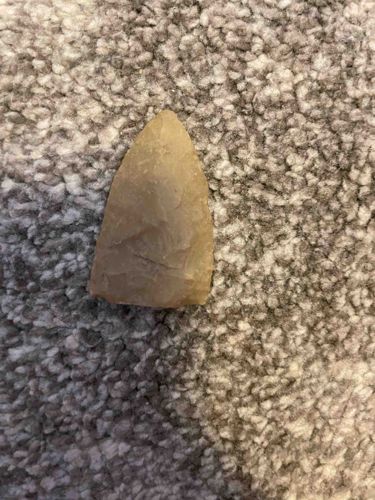
Stone Projectile Point (Arrowhead/Spearhead)
The item is identified as a stone projectile point, likely an arrowhead or spearhead. It exhibits a triangular, elongated shape with a pointed tip and a broader base. The material appears to be chert or flint, characterized by its fine-grained texture and conchoidal fracture patterns visible on the surface. The color is predominantly a light tan or beige, with some subtle variations in hue, possibly indicating natural inclusions or patination. The surface shows evidence of flintknapping, the archaic method of shaping stone tools by percussion and pressure flaking. Numerous small flake scars are discernible across both faces of the point, indicating the intentional removal of material to achieve its final form. The edges, particularly near the tip, appear sharp and well-defined, suggesting functionality as a cutting or piercing implement. There are no clear signs of extensive modern damage such as fresh breaks or chips; the overall condition suggests a natural wear and patination consistent with its age and exposure to the elements. No distinct maker's marks, signatures, or specific manufacturing stamps are visible, which is typical for prehistoric lithic artifacts. Given its appearance and manufacturing technique, this item is estimated to belong to a prehistoric period, potentially from the Paleo-Indian, Archaic, or Woodland periods, depending on its specific typology (which cannot be definitively determined without further context and measurements). The craftsmanship appears to be of moderate quality, with symmetrical flaking and a well-formed tip, indicating skilled knapping.
AI-Generated Appraisal Disclaimer
Estimated Value
$150-300
Basic Information
Category
Archaeological Artifact
Appraised On
November 28, 2025
Estimated Value
$150-300
Item Description
The item is identified as a stone projectile point, likely an arrowhead or spearhead. It exhibits a triangular, elongated shape with a pointed tip and a broader base. The material appears to be chert or flint, characterized by its fine-grained texture and conchoidal fracture patterns visible on the surface. The color is predominantly a light tan or beige, with some subtle variations in hue, possibly indicating natural inclusions or patination. The surface shows evidence of flintknapping, the archaic method of shaping stone tools by percussion and pressure flaking. Numerous small flake scars are discernible across both faces of the point, indicating the intentional removal of material to achieve its final form. The edges, particularly near the tip, appear sharp and well-defined, suggesting functionality as a cutting or piercing implement. There are no clear signs of extensive modern damage such as fresh breaks or chips; the overall condition suggests a natural wear and patination consistent with its age and exposure to the elements. No distinct maker's marks, signatures, or specific manufacturing stamps are visible, which is typical for prehistoric lithic artifacts. Given its appearance and manufacturing technique, this item is estimated to belong to a prehistoric period, potentially from the Paleo-Indian, Archaic, or Woodland periods, depending on its specific typology (which cannot be definitively determined without further context and measurements). The craftsmanship appears to be of moderate quality, with symmetrical flaking and a well-formed tip, indicating skilled knapping.
Get Your Items Appraised
Instant estimates of your treasures with AI-powered instant appraisals